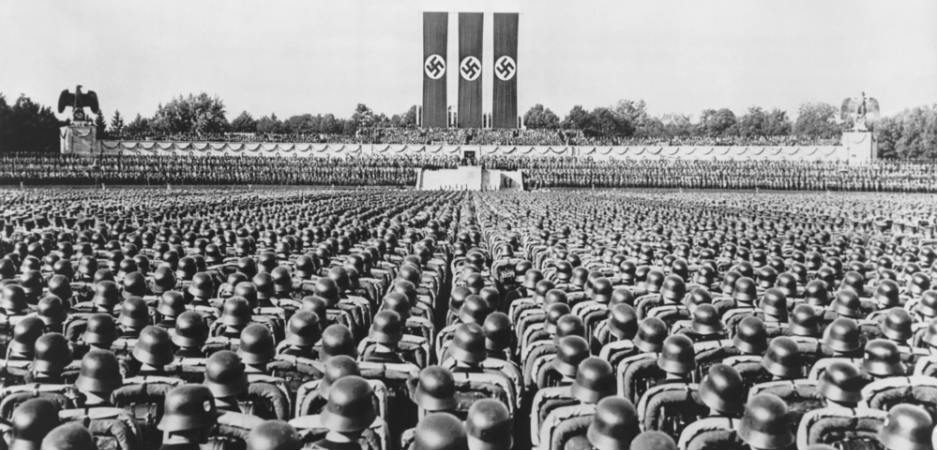Where left-leaning observers warn of a return of totalitarian nationalism, the far right warns of the return of socialist and communist totalitarian politics.
With the rise of populist and far-right politics in Europe and beyond, the fear of the return of totalitarian politics has equally intensified. Comparisons with the rise of fascism in the 1920s are commonplace and drive the headlines of much of the commentary in the media. This fear, however, is not only restricted to observers and opponents of the far right — it has, at least in the case of Germany, become a powerful tool in the ideological strategy of the far right itself. Where left-leaning observers warn of a return of totalitarian nationalism, the far right warns of the return of socialist and communist totalitarian politics.
One example is the PEGIDA (Patriotic Europeans Against the Islamisation of the Occident) movement in Dresden. Convening each Monday, it sees itself in the tradition of the so-called Montagsdemos that ushered in the final days of the socialist German Democratic Republic (GDR). Many of the PEGIDA participants were marching the streets in 1989, not only against the GDR but also in a yearning for a national reunification. Today, they protest against an alleged “Islamization” and “multiculturalization” of Germany.
Comparisons of the current German political system with the late GDR or the EU with the Soviet Union (“EUDSSR”) are widespread among PEGIDA participants. On the level of national politics, the mainstream parties — meaning all the parties except for the far-right Alternative for Germany (AfD), are being framed as “bloc parties,” a term that in the GDR described legally allowed parties that were without any real opposition role or chance to gain political power.
Another commonplace comparison in the contemporary far right is that of the Antifa movement with the Stasi, the GDR’s secret police. German mainstream politics, so the narrative goes, would indirectly fund Antifa projects to threaten and attack far-right politicians and activists just like the Stasi did in the GDR. In far-right circles, the Antifa is portrayed as the embodiment of the return to fascism. In this context, the phrase “When fascism returns, it will not say ‘I am fascism’ but ‘I am anti-fascism,’” attributed to Italian novelist Ignazio Silone, is commonly quoted. Most widespread is the conviction that political correctness and an alleged increasing narrowing of what is allowed to be said mirror the tightening political censorship of the GDR in its last days. Framing today’s political system in terms of GDR resistance has given far right activism a new political framework and boost in mobilization.
This strategy of aligning the Federal Republic of Germany with the GDR goes hand-in-hand with the more established self-portrayal of the far right as a New Right — a right that has nothing to do with National Socialism of the 1930s. Instead, it sees itself in the tradition of the so-called conservative revolution, a group of conservative and right-wing intellectuals in the Weimar Republic, some of whom turned away from the Nazis once they were in power.
Another main reference is Claus von Stauffenberg, a leading member of the plot to assassinate Hitler. He is seen as a representative of the true right, while National Socialism is seen either as a betrayal of right-wing values or portrayed as a far-left movement that has only been labeled “far right” as part of a left-wing strategy to marginalize the right in the postwar era. A symbol for this allegiance is the so-called “Wirmer flag” that is omnipresent in the street movements in Dresden, Cottbus and, most recently, Chemnitz. The flag was designed by Josef Wirmers, member of Stauffenberg’s resistance group, as official flag for a post-Hitler Germany.
Totalitarianism in Theory
Yet the self-portrayal of the far right as the real anti-totalitarian movement is not restricted to popular protest movements. Rather, it has become a canon in far-right alternative online and print media, spanning a spectrum reaching from populist news outlets to highbrow publications aimed at an academic audience. Intellectual legitimization and, increasingly, a totalitarianism theory that lends itself to appropriation by the far right play a central role here. More specifically, far-right intellectuals have appropriated the concept of “totalitarian democracy” to apply it to the German liberal democratic system.
Developed in the early 1950s by Jacob Talmon, the concept of totalitarian democracy describes a system that takes the shape of a messianic movement, driven by utopian calls for egalitarianism and the teaching of a singular and exclusive truth. Part of this messianism is, according to Talmon, an understanding of politics as the art of imposing a holistic philosophy on the society as a whole. At the core is the postulation of a predetermined harmonic order and the idea that all human activity is political.
In opposition to liberal democracies, where progress is achieved pragmatically or coincidentally through trial and error, totalitarian democracy is driven by a clearly defined telos, the achievement of which is seen as an issue of highest urgency. Talmon sees totalitarian democracy as a having emerged alongside liberal democracy in the wake of the French Revolution. While he argues that it can both take the shape of a far left (believing in the predetermining forces of the material world) and far right (believing in the deterministic and natural order of volk and soil), the contemporary far right in Germany argues that we currently see the rise of a neo-socialist totalitarianism in the guise of liberal democracy.
This strategy is, as Jan-Werner Müller has shown as early as in the late 1990s, not a new approach. Yet in the East German post-socialist context, where the memory of socialism is still vivid, it has become a powerful tool to mobilize not only people on the streets, but increasingly a conservative mainstream audience reaching far into public institutions. The consequences this can have could most recently been seen in Chemnitz, where a jail officer leaked an arrest warrant for an Iraqi man suspected of a fatal stabbing.
From Academia to the Far Right
Another, less known but arguably more impactful example is the Hannah Arendt Institute in Dresden. The school is dedicated to the study of totalitarianism and was founded in the wake of German reunification. In the tradition of Talmon’s totalitarianism theory, its aim is to equally analyze totalitarian threats from the far right and the far left. Established mainly by East and West German conservative academics after reunification, Dresden provided the context to establish an approach to totalitarianism that shifted the perceived West German focus on National Socialist totalitarianism to socialist and communist totalitarianism.
While the institute has been providing high-quality research on both communism and National Socialism, its approach to totalitarianism provided one of its researchers, Lothar Fritze, with the grounds to become an influential intellectual in the German far right. In the 1990s, Fritze, who is also professor at the Technical University in Chemnitz, researched mainly GDR-related topics before turning to National Socialism in the 2000s. He published on “allied bombing terror” and critically assessed the legitimacy of Georg Elser’s attempt to assassinate Hitler, an article that was highly disputed among scholars and in the media.
Most recently, his focus has shifted to contemporary politics. Fritze has become a regular contributor to German far-right highbrow publications such as Tumult and Sezession. In his book, The Evil Good Will: World-Saving and Self-Denial in the Migration Crisis, he compares Merkel’s refugee politics to communist messianism as it would be founded on the premise of a utopian borderless global humanity. Just like in totalitarian societies, any critic of Merkel’s universalist approach and her “ideology of welcome culture” would be muzzled.
Liberal Democracy as the Totalitarian “Other”
Another influential book in the far-right milieu is the book by Polish ruling Law and Justice party (PiS) politician and former anti-communist dissident, Ryszard Legutko, The Demon in Democracy: Totalitarian Tendencies in Liberal Societies. The book is written from a post-communist perspective and argues that communism and liberal democracy “prescribe their followers how to think, what to do, how to evaluate things and which language to use.” Both would equally be founded on a belief in an “ideal citizen” and aim to abolish the real differences between human beings and impose conformity in perspectives, language and behavior. Emphasizing his position as a member of the European Parliament, Legutko argues that he has seen “first-hand” how the European institutions develop what he calls, in allusion to Orson Wells, “newspeak.” Instead of accepting the natural order and human differences, the EU’s ideology would construct a “surreal world … that is masking the real world.”
 According to Legutko, both communism and liberal democracy would be “modernisation projects” wanting to change the existing reality in favor of a better world. The society is seen through a technical lens as social problems are depicted as solvable through “social engineering.” Striving for constant progress, any holding on to traditions is perceived, Legutko argues, with skepticism and mockery. In the German edition, an extra paragraph has been added to the introduction. This names the political handling of the refugee crisis as an example of “social engineering” by European elites — with an unprecedented “radical transformation of the existing social identities” and an intrusion of the “social fabric” in the name of the ideology of multiculturalism.
According to Legutko, both communism and liberal democracy would be “modernisation projects” wanting to change the existing reality in favor of a better world. The society is seen through a technical lens as social problems are depicted as solvable through “social engineering.” Striving for constant progress, any holding on to traditions is perceived, Legutko argues, with skepticism and mockery. In the German edition, an extra paragraph has been added to the introduction. This names the political handling of the refugee crisis as an example of “social engineering” by European elites — with an unprecedented “radical transformation of the existing social identities” and an intrusion of the “social fabric” in the name of the ideology of multiculturalism.
Among the German far right, Legutko’s treatise has been celebrated as a brave book by a former anti-communist activist published, as the political consultant of the far right AfD leader Alexander Gauland and influential blogger Michael Klonovsky puts it, “before the beginning of the mass invasion of Europe by fabulously jolly, fertilization-ready and often also splendidly pious fellahs.” For Klonovsky, Legutko’s book shows that the common enemy of communists and liberal democrats is “the individual rooted in traditions.” Just like communism, liberalism has become a dogma marked by a “delusional drive for equality … The catholic minister is supposed to be able to marry. The noble should deny his heritage and leave behind his title. Women should be able to be men (soldier, boxer, policeman). The gay is supposed to be able to have kids. The stupid should be able to study. The African should be able to become a European overnight (the other way around is not possible!). Everybody is supposed to be part of Germany.”
Picking up and distorting arguments from the theory of totalitarianism, the far right does not differentiate between totalitarian and liberal democracies, but directly ascribed the characteristics of totalitarianism to liberal democracies per se. By portraying liberal democracy and communism as totalitarian systems, the far right in Germany has rather successfully coined its image as the sole opposition to an alleged leftist mainstream, with the AfD as the only alternative for Germany. By inscribing itself in the tradition of a patriotism à la Stauffenberg, it differentiates itself from National Socialism and an alleged old right.
Positioning its ideology in that way has allowed the far right to portray itself as a dissident movement — fighting against totalitarianism while whitewashing itself from any totalitarian intentions. Popular images comparing contemporary German politics to communist totalitarianism in street movements have been incorporated by more highbrow circles into the well-established far-right strategy of setting up a quasi-homogenous and totalitarian political opponent. This has allowed the far right to be idolized by its followers as a sole warrior for, and defender of, the nation against an alleged trend of globalizing liberal totalitarianism.
*[The Centre for Analysis of the Radical Right is a partner institution of Fair Observer.]
The views expressed in this article are the author’s own and do not necessarily reflect Fair Observer’s editorial policy.
Support Fair Observer
We rely on your support for our independence, diversity and quality.
For more than 10 years, Fair Observer has been free, fair and independent. No billionaire owns us, no advertisers control us. We are a reader-supported nonprofit. Unlike many other publications, we keep our content free for readers regardless of where they live or whether they can afford to pay. We have no paywalls and no ads.
In the post-truth era of fake news, echo chambers and filter bubbles, we publish a plurality of perspectives from around the world. Anyone can publish with us, but everyone goes through a rigorous editorial process. So, you get fact-checked, well-reasoned content instead of noise.
We publish 2,500+ voices from 90+ countries. We also conduct education and training programs
on subjects ranging from digital media and journalism to writing and critical thinking. This
doesn’t come cheap. Servers, editors, trainers and web developers cost
money.
Please consider supporting us on a regular basis as a recurring donor or a
sustaining member.
Will you support FO’s journalism?
We rely on your support for our independence, diversity and quality.






